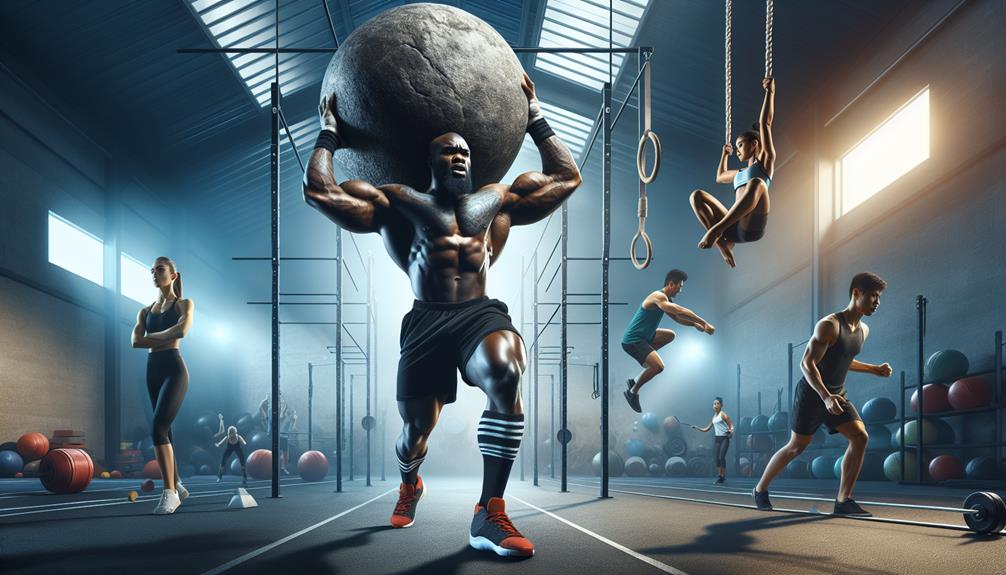When you consider that over 80% of elite athletes incorporate some form of strength training into their routines, it's clear that enhancing physical power and resilience is a key component of athletic success. But have you ever thought about how Strongman training, with its focus on functional movements and raw strength, could take your performance to the next level? The unique blend of lifting, carrying, and pushing/pulling heavy objects in Strongman training not only builds physical strength but also mental fortitude—an often overlooked aspect of sports performance that could be your key to unlocking your full potential.
Key Takeaways
- Strongman training boosts overall strength, power, and functional fitness for athletes.
- Essential for injury prevention and developing explosive strength and agility.
- Enhances mental toughness, resilience, and competitive edge in sports performance.
- Integrating key exercises like Farmer's Walk and Log Press improves strength and power output.
Benefits of Strongman Training
Engaging in Strongman training enhances overall strength, power, and functional fitness for athletes of various disciplines. This type of training is not only beneficial for muscle growth but also plays a crucial role in injury prevention. By focusing on functional strength and explosive power, Strongman training helps athletes develop the physical capacity required to excel in their respective sports.
Research has shown that Strongman exercises such as tire flips, farmer's walks, and log presses can significantly improve an athlete's ability to generate power and move explosively. These movements translate well into sports that require quick bursts of strength and agility, making Strongman training a valuable addition to any athlete's regimen.
Moreover, the dynamic nature of Strongman training helps athletes build resilience and adaptability, preparing them for the unpredictable demands of their sport. By incorporating Strongman exercises into their routine, athletes can enhance their overall performance and take their game to the next level.
Key Strongman Exercises for Athletes
To optimize athletic performance and functional fitness, athletes can incorporate key Strongman exercises that target various muscle groups and enhance explosive power. Strongman training is renowned for its ability to improve functional movements, explosive power, core stability, and grip strength, all of which are crucial for athletes across different sports. Here are some key Strongman exercises that athletes can integrate into their training regimen:
| Exercise | Targeted Muscles | Benefits |
|---|---|---|
| Farmer's Walk | Full body | Enhances grip strength and core stability |
| Tire Flips | Lower body, core | Improves explosive power and functional movements |
| Log Press | Shoulders, triceps | Boosts upper body strength and power output |
Incorporating these Strongman exercises can help athletes develop a well-rounded physical capacity that translates into improved sports performance. Remember to focus on proper form and gradually increase the intensity to maximize the benefits of these exercises.
Integration Into Athletic Training Programs

Integrating Strongman exercises into athletic training programs enhances muscle strength, power, and functional fitness for improved athletic performance. Including Strongman techniques like tire flips, log presses, and farmer's walks can provide athletes with a unique edge in their training regimen. To fully incorporate Strongman training, it's crucial to consider recovery strategies and periodization techniques. Recovery strategies such as adequate rest, nutrition, and mobility work are essential to prevent overtraining and maximize gains from these intense workouts. Periodization techniques, including varying intensity and volume over specific training phases, can help athletes adapt to the demands of Strongman exercises gradually.
Enhancing Strength and Power
Enhancing strength and power in athletes requires a strategic combination of compound movements and progressive overload techniques. To optimize power development and explosive strength, athletes should focus on exercises like deadlifts, squats, and cleans. These compound movements engage multiple muscle groups simultaneously, mimicking the dynamic demands of sports performance.
Progressive overload techniques, such as gradually increasing weights or repetitions, are essential for continual strength gains. Research shows that systematically challenging the muscles promotes adaptation and growth, leading to increased power output over time. Incorporating plyometric exercises like box jumps and medicine ball throws can further enhance explosive strength by improving the rate of force production.
When designing a strength and power training program, it is crucial to tailor exercises to the specific requirements of the sport. By targeting key muscle groups and movement patterns relevant to the athlete's activities, the training becomes more functional and directly applicable to performance improvement. Consistent and structured workouts focusing on compound movements and progressive overload are key elements in unlocking an athlete's full potential in terms of strength and power.
Mental Toughness and Competitive Edge

Shifting focus to Mental Toughness and Competitive Edge, athletes can elevate their performance by honing their psychological resilience and sharpening their strategic edge. Mental focus is a critical component in achieving peak athletic performance. Research shows that athletes who develop strong mental toughness are better equipped to handle the pressures of competition, stay focused under stress, and push through challenges.
Psychological preparation involves techniques such as visualization, goal setting, and positive self-talk. By incorporating these strategies into their training regimen, athletes can enhance their mental resilience and improve their competitive edge. Studies have demonstrated that athletes who engage in mental preparation techniques exhibit increased confidence, reduced anxiety, and improved overall performance.
To gain a competitive edge, it is essential for athletes to cultivate mental toughness and focus on psychological preparedness. By developing these skills, athletes can optimize their performance, overcome obstacles, and excel in their respective sports. Remember, mental strength is just as crucial as physical strength in achieving success on the field or in competition.
Frequently Asked Questions
Can Strongman Training Be Used as a Form of Cross-Training for Athletes in Non-Strength Based Sports?
Incorporating strongman training can boost your strength endurance and power output, aiding in your overall athletic performance. It offers unique challenges that complement traditional training, but ensure you prioritize recovery strategies and injury prevention techniques.
Are There Any Specific Nutritional Guidelines or Dietary Recommendations for Athletes Incorporating Strongman Training Into Their Routines?
When incorporating strongman training, focus on nutritional strategies to support your body's demands. Plan balanced meals that include protein, carbs, and healthy fats. Stay hydrated, utilize recovery methods like stretching and adequate sleep to optimize performance and minimize injury risks.
How Does Strongman Training Impact an Athlete's Flexibility and Mobility Compared to Traditional Strength Training Methods?
When comparing strongman training to traditional strength methods, you'll notice enhanced flexibility gains and mobility improvements. The dynamic movements in strongman exercises challenge your body in unique ways, leading to increased range of motion and agility.
Are There Any Potential Risks or Injuries Associated With Strongman Training That Athletes Should Be Aware Of?
When diving into strongman training, remember that injury prevention is key. Prioritize risk management by focusing on safety measures. By understanding potential risks and taking precautions, you can optimize performance while keeping yourself safe.
How Can Athletes Track and Measure Their Progress in Strongman Training to Ensure They Are Making Improvements in Their Sports Performance?
To track progress in strongman training, athletes should use performance metrics like weight lifted, time to complete tasks, and body measurements. Analyzing these data points will show strength gains and athletic improvements over time.
Conclusion
In conclusion, incorporating strongman training into your athletic regimen can be a game-changer. By harnessing the power of key exercises and integrating them into your training program, you can boost your strength, power, and mental toughness. This unique form of training will give you the competitive edge you need to excel in your sport. So why wait? Dive into the world of strongman training and watch your sports performance soar to new heights.













